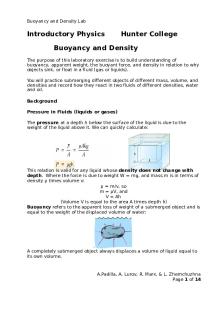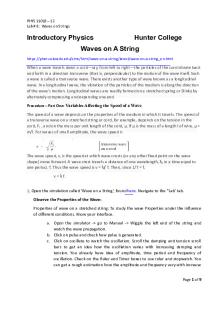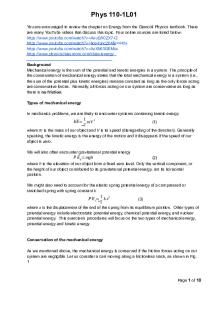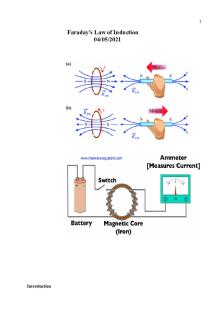Phys lab 10 - Lab report PDF

| Title | Phys lab 10 - Lab report |
|---|---|
| Author | Jeffrey Jakubz |
| Course | General Physics: Introductory Course In Mechanics Heat And Sound |
| Institution | Hunter College CUNY |
| Pages | 14 |
| File Size | 817.7 KB |
| File Type | |
| Total Downloads | 65 |
| Total Views | 172 |
Summary
Lab report...
Description
Buoyancy and Density Lab
Introductory Physics
Hunter College
Buoyancy and Density The purpose of this laboratory exercise is to build understanding of buoyancy, apparent weight, the buoyant force, and density in relation to why objects sink, or float in a fluid (gas or liquids). You will practice submerging different objects of different mass, volume, and densities and record how they react in two fluids of different densities, water and oil. Background Pressure in Fluids (liquids or gases) The pressure at a depth h below the surface of the liquid is due to the weight of the liquid above it. We can quickly calculate:
This relation is valid for any liquid whose density does not change with depth. Where the force is due to weight W = mg, and mass m is in terms of density ρ times volume v: ρ = m/v, so m = ρV, and V = Ah (Volume V is equal to the area A times depth h) Buoyancy refers to the apparent loss of weight of a submerged object and is equal to the weight of the displaced volume of water:
. A completely submerged object always displaces a volume of liquid equal to its own volume.
A.Padilla, A. Lurov, R. Marx, & L. Zhemchuzhna Page 1 of 14
Buoyancy and Density Lab Buoyant Force and Archemides’ Principle Buoyant force FB: Net upward force that a fluid exerts on an object. Relates buoyancy to displaced liquid. There is a net force on the submerged object in a fluid because the pressures at the top and bottom of it are different. The buoyant force is found to be the upward force on the same volume of water:
Apparent weight w’ of a submerged object is equal the true Weight W minus the Buoyant Force FB: W’ = W – FB (apparent weight) Example: If a 3-kg block submerged in water apparently "weighs" 2 kg, then the buoyant force or weight of water displaced is 1 kg.
Principle of flotation: ● A floating object displaces a weight of fluid equal to its own weight. ● Example: A solid iron 1-ton block may displace 1/8 ton of water and sink. The same 1 ton of iron in a bowl shape displaces a greater volume of water—the greater buoyant force allows it to float.
Archimedes’ Principle: States that an immersed body (completely or partially) is buoyed up by a force equal to the weight of the fluid it displaces. Applies to gases and liquids (fluids). ● FB for an immersed object is equal to the weight of water displaced FB = ρfVog, where ρf is the fluid density, Vo is the volume of the object A.Padilla, A. Lurov, R. Marx, & L. Zhemchuzhna Page 2 of 14
Buoyancy and Density Lab
FT’ = -mg + FB ● FB for a partially immersed floating object is equal to the weight of the object FB = ρoVog, where ρo is the fluid density, Vo is the volume of the object
● For a floating object, the fraction that is submerged is given by the ratio of the object’s density to that of the fluid ρo/ ρf, where ρF> ρo ● Specific Gravity is ratio of the density of the floating object to the fluid density, specific gravity = ρo/ ρf Lab Experiment Procedures (Virtual Exercise) Procedure 1: Open the Buoyancy Virtual Lab https://phet.colorado.edu/sims/density-and-buoyancy/buoyancy_en.html
A.Padilla, A. Lurov, R. Marx, & L. Zhemchuzhna Page 3 of 14
Buoyancy and Density Lab Procedure 2: Familiarize yourself with the experiment’s tools. With the Blocks selected “Same Mass”, upper right of the screen, ● sink the blocks, one at a time. ● Note the fluid volume change and weight change for each block. ● Click and drag on each block and drop them in the fluid. ● Weigh the objects on the scale in, and out of, the fluid. ● Note how you can include the forces and masses by selecting the options on the lower left of the screen. ● Note how you can change the type of fluid you immerse the objects at the bottom, center of the screen. Procedure 3: Buoyant Force vs Volume Displaced Make a prediction on how the Buoyant force of an object changes over depth (displaced volume) as you submerse it in a fluid. I predict that the buoyant force increases as the depth increases, linearly. Sketch your Prediction of the Buoyant Force FB vs. Volume Displaced Ldisplaced. Force should be on the vertical access and the Displaced Volume should be on the horizontal axis. 5 points Note: You can insert lines to sketch on the graph, or attach a screenshot of a graph, whatever is easiest for you.
Procedure 4: Now, experiment to see how the Buoyant force changes with depth as you submerse an object in water:
A.Padilla, A. Lurov, R. Marx, & L. Zhemchuzhna Page 4 of 14
Buoyancy and Density Lab
● Select Water as the fluid (on the bottom of the screen) and Same Masses (upper right) ● Select “Show Forces” Buoyancy and “Read Outs” Masses and Forces, at the lower left of the screen ● Starting at the surface of the water submerge the 5kg wood block displacing about 2L of water each time, then continue until the block is at the bottom of the tank. ● Fill in the data table below 5 points Data Table Procedure 4: 5 Kg Wood Block in Water Collected/Recorded Data Tria Wood Volume Buoyant Force FB [N] Submerged l Vo [L] = _____ L Displaced Fluid Volume Vf [L]
1 2 3 4 5 6 7 8 9 10
12.5 12.5 12.5 12.5 12.5 12.5 12.5 12.5 12.5 12.5
0 1.95 2.97 4.01 5.0 6.0 8.0 10.02 Near the Bottom Bottom of tank
0 19.07 29.15 39.33 49.0 58.77 78.45 98.24 122.50 122.50
A.Padilla, A. Lurov, R. Marx, & L. Zhemchuzhna Page 5 of 14
Buoyancy and Density Lab
A.Padilla, A. Lurov, R. Marx, & L. Zhemchuzhna Page 6 of 14
Buoyancy and Density Lab
Procedure 4 Questions 1. Plot FB Vs. Ldisplaced 5 points
Displaced Fluid Volume vs Buoyant Force 140
Buoyant Force FB (N)
120
R² = 1
100 80 60 40 20 0
0
2
4
6
8
10
12
14
Displaced Fluid Volume Vf [L]
2. How does the magnitude of the Buoyant Force on the wood block change over depth from the surface to the bottom of the tank? 3 points A.Padilla, A. Lurov, R. Marx, & L. Zhemchuzhna Page 7 of 14
Buoyancy and Density Lab The magnitude of the Buoyant force on the wood blood changes linearly with the block, increasing until the wood block reaches the bottom, which is the highest value of Buoyancy force. The R2 value shows that it is perfectly linear. 3. How much water is displaced, at the maximum value of the Buoyant Force? How does this displaced volume relate to the volume of the block? 3 points The water is displaced 12.5L at the maximum value of the buoyant force. This displaced volume relates to the volume of the block in that it is exactly the same volume of the wood block. Procedure 5 Now repeat the procedure steps for the 5 kg brick in oil. This time decrease the increments of displaced fluid to about 0.5 L. 5 points Data Table Procedure 5: 5 Kg Brick in Oil Collected/Recorded Data Tria Brick Volume Submerged l Vo [L] = _____ L Displaced Fluid Volume Vf [L]
1 2 3 4 5 6 7 8 9 10
2.5 2.5 2.5 2.5 2.5 2.5 2.5 2.5 2.5 2.5
0 0.1 0.5 1.75 2.01 2.05 2.2 2.35 Near the Bottom Bottom of tank
Buoyant Force FB [N]
0 0.9 4.5 15.77 18.12 18.46 19.81 21.16 22.49 22.49
A.Padilla, A. Lurov, R. Marx, & L. Zhemchuzhna Page 8 of 14
Buoyancy and Density Lab
Procedure 5 Questions: 4. Do you expect the shape of Plot FB Vs. Ldisplaced for the brick to be the same or different than for the wood block? Explain why or why not according to your data (you do not need to plot this, unless you find that your data suggests a different plot than in Procedure 4. 3 points I expect the shape of the plot for the brick to be the same as the plot for the wood block. This is because both the buoyancy force and the volume increase in relation with one another.
A.Padilla, A. Lurov, R. Marx, & L. Zhemchuzhna Page 9 of 14
Buoyancy and Density Lab
Displaced Fluid Volume vs Buoyant Force
Buoyant Force FB (N)
25 R² = 1
20 15 10 5 0
0
0.5
1
1.5
2
2.5
3
Displaced Fluid Volume Vf [L]
5. How much oil is displaced, at the maximum value of the Buoyant Force? How does this displaced volume relate to the volume of the brick? Are they the same or different? 3 points At the maximum value, 2.5L of oil is displaced. This displacement is the exact volume of the brick that is placed in the oil. Procedure 6: Floating Objects, the Buoyant Force FB, Apparent Weight W’, and Density (Water and Oil) Same Mass ● Select “Same Mass” option and water as the fluid. ● Submerge the 5kg wood block. Once it stops bobbing up and down, record the following data in the table below ● Now change the fluid to oil and record the data to complete the data for this 5kg wood block ● Remove the wood block and change the fluid back to water ● Submerge the 5kg brick in the water. Once the brick falls to the bottom, record the data in the table below ● Change the fluid to oil, and continue recording the data for this 5 kg brick Same Volume ● Select the “Same Volume” option and water as the fluid ● Submerge the 2kg wood block. Once it stops bobbing up and down, record the following data in the table below ● Now change the fluid to oil and record the data to complete the data for this 2kg wood block ● Remove the wood block A.Padilla, A. Lurov, R. Marx, & L. Zhemchuzhna Page 10 of 14
Buoyancy and Density Lab ● Submerge the10kg brick in water. Once it reaches the bottom of the tank record the data in the table below. ● Change the fluid to oil and continue recording the data for the 10kg brick. Same Density ● Select the “Same Density” option and water as the fluid ● Submerge the 4kg wood block. Once it stops bobbing up and down, record the following data in the table below ● Now change the fluid to oil and record the data to complete the data for this 4kg wood block. Completed Table is Worth 10 Points Data Table Procedure 6: Floating Object, the Buoyant Force, Apparent Weight, Displaced Fluid, and Density in Water and Oil Object in Water Object in Oil Density of Fluid Collected/Recorded Calculated Observation Collected/Recorded Data Observ Collected/Recorded Water Data Data e Data Displace d Δ Lwater Object Objec Which fluid Apparent Oil Water Buoyant Object’s Sink or Buoyant Apparent t has the Weight Weight Displaced Displace Force True Float? Force greatest W’ = W’ = Mass Δ Loil [L] d FB [N] Weight FB [N] density? Wo – FB Wo – FB [Kg] Δ Lwater W = Mg [N] [N] [L] [N]
Wood brick
5 5
49N 49N
float sink
Wood
2
float
brick
10
19.6 N 98N
wood
4
39.2 N
float
sink
49N 24.5 N 19.6 N 49N
0N 24.5N
5.0L 2.5L
0N
2.0L
49N
5.0L
39.2 N
0N
4.0L
49N 22.49 N 19.6N
0N 26.51 N 0N
5.45L 2.5L
Water Water
2.18L
Water
44.98 N 39.2N
53.02 N 0N
5.0L
Water
4.36L
Water
A.Padilla, A. Lurov, R. Marx, & L. Zhemchuzhna Page 11 of 14
Buoyancy and Density Lab
Procedure 6 Questions: 6. Based on your data, what causes an object to float? Or, how does the Buoyant Force relate to the Weight of an object that floats? Is the Buoyant Force less than, equal to, or greater than the Weight of the object? 3 points The density of an object can cause an object to float; if they are less dense than the liquid, it will float. The buoyant force relates to the weight of an object that floats because the magnitude of the weight will be equal to the buoyancy force. 7. The greatest displaced fluid volume has 3 points The greatest density
or
The least density
8. The fluid with the greatest buoyant force has 3 points The greatest density
or
The least density
9. The fluid in which the object has the greatest apparent weight has 3 points The greatest density
or
The least density
Procedure 7: Challenge 10 points How can you make one of the bricks float? Take a screen shot of your floating brick and explain why the brick floated in terms of how you manipulated/changed the volume, density, etc.
A.Padilla, A. Lurov, R. Marx, & L. Zhemchuzhna Page 12 of 14
Buoyancy and Density Lab The brick is able to float because it is on top of the wood and is not actually submerged in the water. This is floating because the density of the wood is lower than that of the water. Post Lab Questions: 10. Why do you float better in salt water than in fresh water, if the buoyant force is the same in either fluid? Which fluid do you displace the least water, salt water or fresh water? The density of fresh water and salt water is 1.00kg/m3 and 1.025kg/m3, respectively. 4 points You float better in salt water than in fresh water because salt water has a higher density due to the added salt. You would displace the fresh water more than the salt water, as the fresh water has a lower density, and an object is more likely to float if it is in a more dense liquid. 11. Using Newton’s Second law write the equation that describes the sum of the forces acting on a 4 points a. floating object. FB = m*g b. object that sank to the bottom. m*g – FB = m*a c. object that is sinking. m*g – FB = m*a 12. Use the equation of motion to show that once released from submersion the magnitude of the acceleration a, for the object that ascends (floating to the surface), in terms of the density of the fluid and object is: 4 points a = (ρoil /ρ1 – 1)g FB-m*g=m*a poil*v1*g-p1*v1*g=p1a a = (poil-p1)*g / p1 a = g*((poil/p1)-1) 13. Use one of the previous equations to determine the density of the oil? 4 points a = g*((poil/p1)-1) Poil = ((a*)+1*p1 The given value for acceleration is not given by the problem. As such, it is not possible for the value of density of oil to be solved. 14. If I told you the oil is olive oil, how sure are you, that I am correct? Compare your result, with the accepted value of ρolive-oil = 0.916 kg/L, i.e. calculate the percent error of your calculation. 4 points The value of acceleration was not given in problem #13, so the A.Padilla, A. Lurov, R. Marx, & L. Zhemchuzhna Page 13 of 14
Buoyancy and Density Lab question can not be solved for the density of oil. If the answer was to be solved, it would be using this formula: (densityobserved – densitygiven) / (densitygiven) * 100% = percent error 15. A hot air balloon along with its cargo has a mass of 4.0 x 105 kg, and it holds 7.0 x 105 m3 of hot air. It is floating up at a constant height in air with a density of 1.29 kg/m3. Show that the hot air has a density of 0.72kg/m3. 4 points FB = m*g + M*g pair*v*g = M*g + phot air *v*g phot air = pair – M/v phot air = 1.29kg/m3 – (4*105 kg)/(7*105 m3) phot air = 0.72 kg/m3
A.Padilla, A. Lurov, R. Marx, & L. Zhemchuzhna Page 14 of 14...
Similar Free PDFs

Phys lab 10 - Lab report
- 14 Pages

Phys lab 4 - Lab report
- 10 Pages

Phys lab 8 - Lab report
- 9 Pages

Phys lab 5 - Lab report
- 10 Pages

Phys lab report 2
- 14 Pages

PHYS Lab Report 3
- 7 Pages

Lab 10 - Lab 10 Report
- 7 Pages

Phys lab 6 - Lab report 6
- 13 Pages

Phys 208 Lab Report # 3
- 3 Pages

LAB Report #4 phys 224
- 5 Pages

PHYS 215 Vectors - Lab Report
- 2 Pages

Lab report 4 int phys
- 4 Pages

Chem lab 10 - lab report
- 9 Pages

Orgo 2 Lab 10 - Lab Report 10
- 4 Pages

Lab 201 Phys 2 Lab - Lab
- 4 Pages

Post Lab Report 10
- 8 Pages
Popular Institutions
- Tinajero National High School - Annex
- Politeknik Caltex Riau
- Yokohama City University
- SGT University
- University of Al-Qadisiyah
- Divine Word College of Vigan
- Techniek College Rotterdam
- Universidade de Santiago
- Universiti Teknologi MARA Cawangan Johor Kampus Pasir Gudang
- Poltekkes Kemenkes Yogyakarta
- Baguio City National High School
- Colegio san marcos
- preparatoria uno
- Centro de Bachillerato Tecnológico Industrial y de Servicios No. 107
- Dalian Maritime University
- Quang Trung Secondary School
- Colegio Tecnológico en Informática
- Corporación Regional de Educación Superior
- Grupo CEDVA
- Dar Al Uloom University
- Centro de Estudios Preuniversitarios de la Universidad Nacional de Ingeniería
- 上智大学
- Aakash International School, Nuna Majara
- San Felipe Neri Catholic School
- Kang Chiao International School - New Taipei City
- Misamis Occidental National High School
- Institución Educativa Escuela Normal Juan Ladrilleros
- Kolehiyo ng Pantukan
- Batanes State College
- Instituto Continental
- Sekolah Menengah Kejuruan Kesehatan Kaltara (Tarakan)
- Colegio de La Inmaculada Concepcion - Cebu